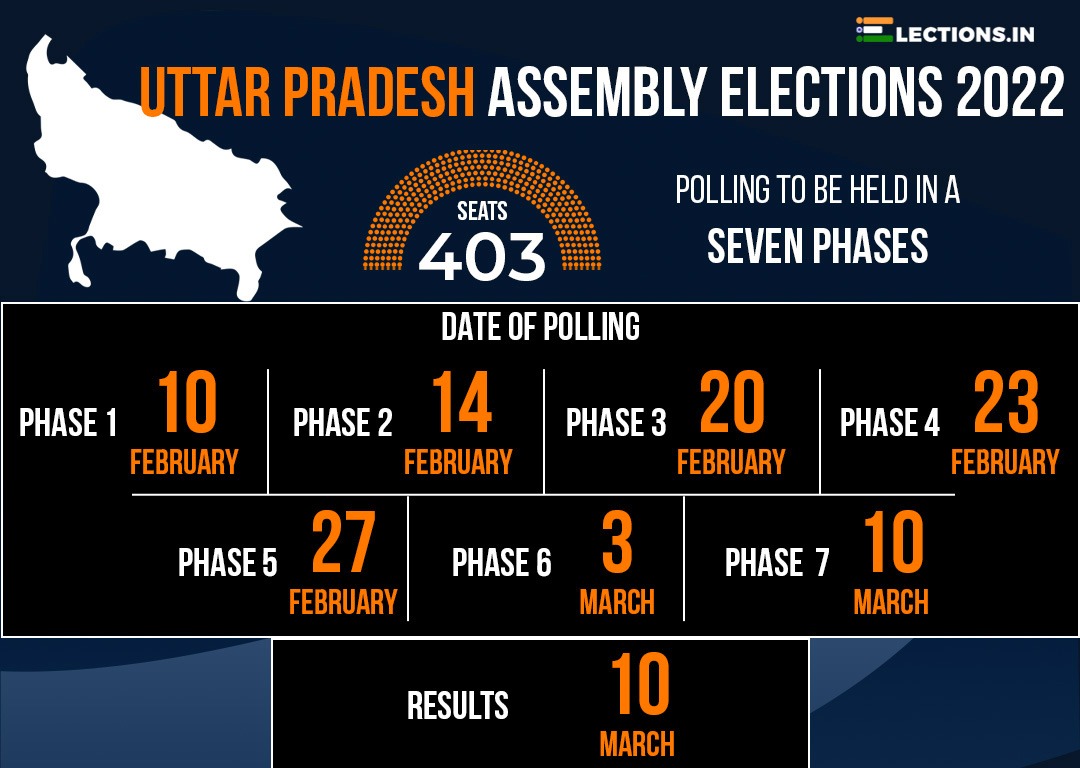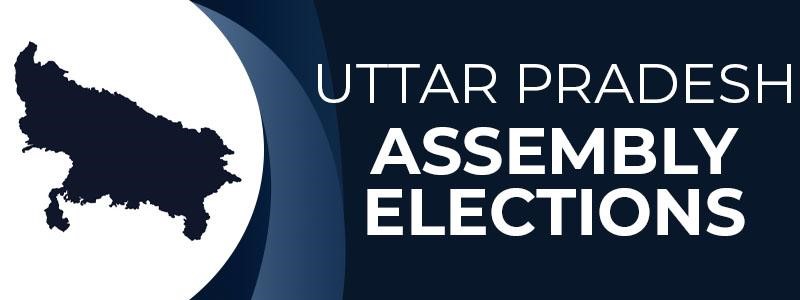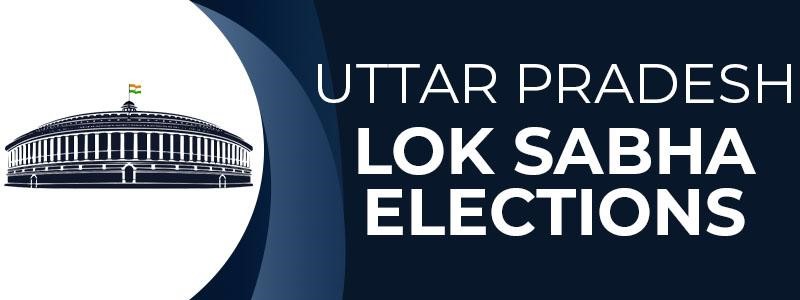Track your constituency
Live News
Uttar Pradesh Election (UP Election) - UP Assembly Constituencies & UP Parliamentary Constituencies


Uttar Pradesh Phase wise Election Dates 2022
| Phase No. | Nomination Date | Polling Date | No. of Constituencies (Total-403) |
|---|---|---|---|
| Phase-1 | 14-Jan | 10-Feb | 58 |
| Phase-2 | 21-Jan | 14-Feb | 55 |
| Phase-3 | 25-Jan | 20-Feb | 59 |
| Phase-4 | 27-Jan | 23-Feb | 60 |
| Phase-5 | 01-Feb | 27-Feb | 60 |
| Phase-6 | 04-Feb | 03-Mar | 57 |
| Phase-7 | 10-Feb | 07-Mar | 54 |
| Result Date | 10-Mar | ||
Uttar Pradesh Elections (UP Elections), the Uttar Pradesh Assembly Election is held every 5 years. Uttar Pradesh Assembly election polling is held in Seven Phases for 403 constituencies. Uttar Pradesh Assembly Election 2022 are scheduled from 10 February - 10 March, 2022. The counting of votes and Results will be declared on 10 March, 2022.
| Uttar Pradesh Election Quick Facts | |
|---|---|
| Deputy Chief Minister(s) | Keshav Prasad Maurya, Dr. Dinesh Sharma |
| Governor of UP | Anandiben Mafatbhai Patel |
| Vidhan Sabha Speaker | Hriday Narayan Dikshit |
| Government | Bhartiya Jnata Party |
| Opposition | Samajwadi Party |
| Others | The Bahujan Samaj Party, The Indian National Congress, The Rashtriya Lok Dal |
| UP Next Election | Feb/Mar 2022 |
| UP Next Election | Feb/Mar 2022 |
| Last elections | 2017 |
| Lok Sabha | 80 |
| Rajya Sabha | 31 |
| Vidhan Sabha | 403 |
| Vidhan Parishad | 100 |
| Uttar Pradesh Area | 2,43,286 Sq.Kms. |
| Uttar Pradesh Population | 19,95,81,477* (2011) |
| Principal Languages | Hindi & Urdu |
| Capital of Uttar Pradesh | Lucknow |
Uttar Pradesh Election Results:
Uttar Pradesh Government and Polity
Government & Politics:
The state of Uttar Pradesh is one of the seven in the country which has a bicameral legislature with two houses -the lower and the upper. The lower house is the Vidhan Sabha (State Legislative Assembly) and the Upper house is called the Vidhan Parishad (Legislative council). The Vidhan Sabha had 431 members till 1967, but now the Vidhan Sabha consists of 403 directly elected members and one nominated member from the Anglo-Indian community who are elected for five-year term. The Vidhan Parishad has 100 members with one-third (33 members) retiring every two years. Since Uttar Pradesh sends the most legislators to the national Parliament, it is often considered to be one of the most important states with respect to Indian politics.Uttar Pradesh has 80 parliamentary constituencies out of which 17 are reserved for a candidate belonging to scheduled caste. The state has 403 legislative assembly constituencies out of which 85 are reserved for a candidate belonging to scheduled caste. The state contributes 31 seats to the upper house, the Rajya Sabha.
Administration:
Divisional administration:The Indian state of Uttar Pradesh is made up of 75 administrative districts that are grouped into 18 divisions. Each division consists of 3-7 districts. A divisional commissioner an officer of Indian Administrative service (IAS) is responsible for heading the administration of a division; the Divisional minister is also responsible for the collection of revenue and maintenance of law and order in his or her division.
District administration:
A district of an Indian state is an administrative geographical unit. The Indian state of Uttar Pradesh is made up of 75 administrative districts, headed by a district magistrate and collector, an IAS officer. The district magistrate is responsible for coordinating the work between various departments in the district, is responsible for law and order in the district and is also given the power of an executive magistrate.
Judiciary:
The judiciary in the UP state consists of the Allahabad High Court in Allahabad, the Lucknow Bench of Allahabad High Court, district courts and session courts in each district or Sessions Division, and lower courts at the tehsil level. The President of India appoints the chief justice of the High Court of the Uttar Pradesh judiciary on the advice of the Chief Justice of the Supreme Court of India as well as the Governor of Uttar Pradesh. Other judges are appointed by the President of India on the advice of the Chief Justice of the High Court. Subordinate Judicial Service, categorized into two divisions.
- Uttar Pradesh civil judicial services
- Uttar Pradesh higher judicial service
Uttar Pradesh Vidhan Parishad Elections
State Legislative Assembly (Vidhan Sabha)
The last Vidhan Sabha election was held in March 2012. The poll was held in seven phases. The total number of political parties- national, state and registered (unrecognized)- which participated in the Vidhan Sabha election was 222. The number of contestants in the fray was 6839. The number of electors was 127492836. The number of electors who voted was 75725793, which was 59.40% or the total number of electors.The Bahujan samaj party won 80 seats, the BJP won 47 seats, the Nationalist Congress Party won 1 seat, the INC won 28, Rashtriya Lok Dal won 9 seats, and the Samajwadi Party won 224 seats. Samajwadi party formed the government with Shri Akhilesh Yadav as the Chief Minister.
The Speaker of the state legislative assembly is Shri Mata Prasad Pandey. The Leader of the Opposition is Shri Swami Prasad Maurya of the Bahujan Samaj Party. Check the members of Legislative Assembly (MLAs) of Uttar Pradesh...
State Legislative Council (Vidhan Parishad)
The Vidhan Parishad is a permanent house of 100 members. The members are elected or nominated for six years and one sixth of them retire every two years. Out of the 100 Legislative Council members, 10 are nominated by the Governor. The rest are elected by various electoral colleges in the state such as those of the Vidhan Sabha members, local bodies, teachers and graduates.Some of the current Vidhan Parishad members are Shri Parmeshwar Lal (BSP), Shri Jitendra Yadav(BSP), Shri R S Kushwaha(BSP), Shri Akshay Pratap Singh (SP), and Shri Dinesh Pratap Singh (INC).
History of Uttar Pradesh Elections
About Uttar Pradesh Elections
The Indian National Congress has dominated the state's politics since independence. In the late nineties the rise of regional parties such as Samajwadi Party (SP) and Bahujan Samaj Party (BSP) has challenged the traditional political base of the INC in the state. The BSP came to power in the state 2007 with an absolute majority. The Bharatiya Janata Party (BJP) is also a major party in the state. In the 2009 Lok Sabha elections the INC won 21 seats while the BSP won 20 and the SP won 23 seats. The BJP won 10 seats.Some recent prominent politicians of the state are the former Chief Minister of the state, Shri Mulayam Singh Yadav of the SP , who has also served as the Defense Minister of the country and Shri Kanshi Ram , the founder of the Bahujan Samaj party. Shri Atal Behari Vajpayee, the 10th Prime Minister of India represented Lucknow, the capital of UP, in the Lok sabha Smt Sonia Gandhi, Shri Rahul Gandhi, , Dr Murali Manohar Joshi (BJP), Smt Menaka Gandhi are all Lok Sabha MPs from the state.
Issues of the State
There are a number of issues facing the state of Uttar Pradesh today among which the law and order situation is most critical. However, matters of caste and religion tend to take away the spotlight from core issues in the run-up to every assembly election in this state. Uttar Pradesh has a very high incidence of poverty with more than 29.4 % of its population living below poverty line. The average household income is almost half of the national average. The quality of basic infrastructure such as education, power supply, roadways is deplorable and corruption is the prime reason for such sad state of affairs. This is also pushing the state further into poverty.Uttar Pradesh Legislature
The state is one of the few in the country which has a bicameral legislature with two houses -the lower and the upper. The lower house is the Vidhan Sabha or the State Legislative Assembly and the Upper house is called the Vidhan Parishad or the Legislative council. The Vidhan Sabha had 431 members till 1967, but now the Vidhan Sabha consists of 403 directly elected members and one nominated member from the Anglo-Indian community. The Vidhan Parishad has 100 members.Constituencies in Uttar Pradesh
Uttar Pradesh has 80 parliamentary constituencies out of which 17 are reserved for a candidate belonging to scheduled caste. The state has 403 legislative assembly constituencies out of which 85 are reserved for a candidate belonging to scheduled caste.Last Updated on: Jan 08, 2022


